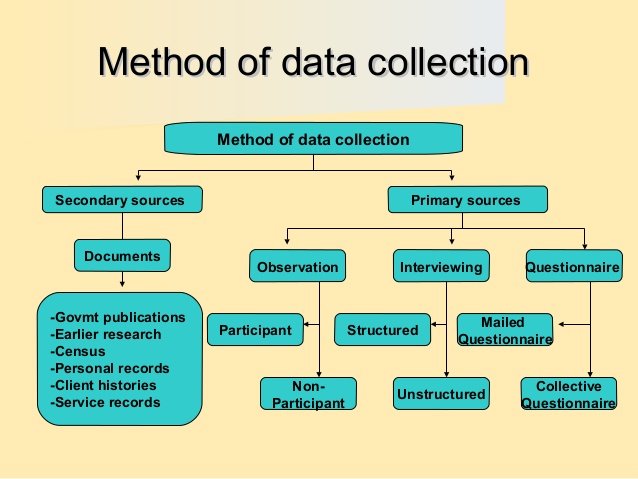Data are the special type of information generally obtained through observations, surveys, inquiries, or are generated as a result of human activity. Methods of data collection are essential for anyone who wish to collect data. Data collection is a fundamental aspect and as a result, there are different methods of collecting data which when used on one particular set will result in different kinds of data. Collection of data refers to a purpose gathering of information and relevant to the subject-matter of the study from the units under investigation. The method of collection of data mainly depends upon the nature, purpose and the scope of inquiry on one hand and availability of resources, and the time to the other. The statistical Data may be classified into primary and secondary depending upon the nature and mode of collection.
Data collection is a very important part of science. Meteorologists data related to weather over time to keep a record and makes forecasts on basis of it. Other example include Oceanographers collecting data on the salinity (saltiness) of seawater studying changes in trends of our Earth’s oceans. Although have been collected by hand for thousands of years, the technology to collect data electronically has been around for fewer than 80 years and made significant development in this time period. Only in the last 20 years this technology and advanced methods have been available to us.

Data Collection Methods:
Data collection is a process of collecting information from all the relevant sources to find answers to the research problem, test the hypothesis and evaluate the outcomes. Data collection methods can be divided into two categories: secondary methods of data collection and primary methods of data collection.
Methods of data collection for primary and secondary Data
(1) Primary data
Primary data are original observations collected by the researcher or his agent for the first time for any investigation and used by them in the statistical analysis.
The primary data is the one type of important data. It is collection of data from first hand information.
This information published by one organization for some purposes. This type of primary data is mostly pure and original data.
The primary data collection is having three different data collection methods are:
- Data Collection through Investigation:
In this method, trained investigators are working as employees for collecting the data. The researchers will use the tools like interview and collect the information from the individual persons.
- Personal Investigation Methods:
The researchers or the data collectors will conduct the survey and hence they collect the data. In this method we have to collect more accurate data and original data. This method is useful for small data collection only not big collection of data projects.
- Data Collection through Telephones:
The data researcher uses the tools like telephones, mobile phones to collect the information or data. This is accurate and very quick process for data collection. But information collected is not accurate and true.
(2) Secondary data
The secondary data is the other type of data, which is collection of data from second hand information. This information is known as, given data is already collected from any one persons for some purpose, and it has available for the present issues. And mostly these secondary data’s are not relevant and pure or original data
Two important Methods:
a) Official methods:
Data collecting from the ministry of finance, Agriculture, Industry and etc. These data collection methods are official methods. This method is used the tools of phone calls and surveys.
b) Semi–official methods:
This is the method of data collection from Railway boards, banks, population committee etc. This methods only used for the focusing groups, and interviews, and electronic mail surveys.
Ways of Collections
In this case the data’s are already available, it means the data’s are already collected and analyzed by someone else. It can be either published or unpublished data. When using the secondary data, the following characteristics must be followed:
- Reliability
- Suitability
- Adequate data
These data’s can be collected from the following places:
- a) Official
- b) Newspapers and journals
- c) Research organizations like universities.
Secondary sources are data that already exist
- Previous research
- Official statistics
- Mass media products
- Diaries
- Letters
- Government reports
- Web information
- Historical data and information